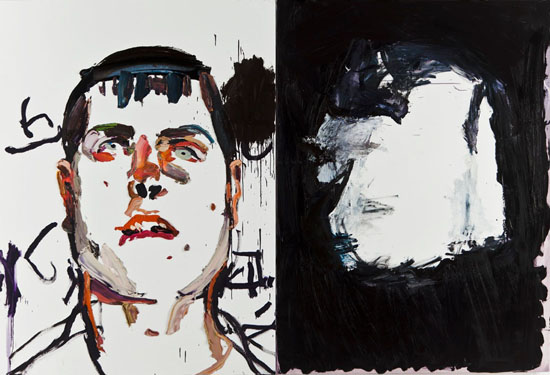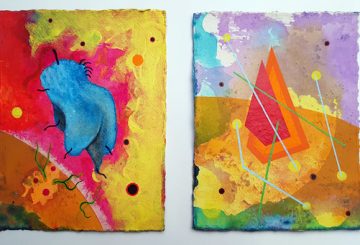In 2011 Australian artist Ben Quilty was commissioned by The Australian War Memorial to travel to Afghanistan as the official war artist. Quilty spent a month in Afghanistan with the Australian Defence Force (ADF) to record the experiences of defence personnel involved with Operation Slipper. His latest exhibition Ben Quilty: After Afghanistan opens shortly at the National Art School in Sydney – where Quilty will be exhibiting 21 studio paintings, and 16 works on paper sketched during his time in Afghanistan. Sharne Wolff spoke to him about art & war, his recent appointment as a Trustee on the Board of Trustees of the Art Gallery of NSW, and more…
Ben Quilty, Trooper Daniel Spain, 2012. Oil on linen diptych, 190x280cm.
Sharne Wolff. You have a wife and kids. Was it difficult to decide to accept the position as official war artist in Afghanistan?
Ben Quilty. The appointment was difficult to accept. Saying that I had no doubt that ‘yes’ was the best answer to give. I’d been paranoid about conscription as a boy, and actively anti-war as an art student in the early 90’s. My work has been an autobiographical account of the nature of modern masculinity in Australia so it seemed like the ultimate test of my own work and of masculinity under the most extreme pressure. My family was worried about it and I was anxious. That’s the truth.
SW. Did you prepare yourself for what you would see in Afghanistan before you left Australia?
BQ. I didn’t prepare much. I worked in current affairs TV as an editor in the late 90s. I saw so much raw footage of death and destruction, most of which never makes our screens. I stopped looking at what other Australian artists had made as official war artists, even though the memorial offered me complete access to everything, from Arthur Streeton to Wendy Sharpe. I just believed that such an extreme experience was going to drive me into the studio whether I planned it or not.
SW. In his book ‘Uncommon Soldier’, journalist Chris Masters talks about the disconnected digger and the “chasm between political and public support for the Afghanistan mission”. Did you have to put aside any political/personal views about the War generally to accept the position? Do you feel differently about the War after witnessing some of it first hand?
BQ. It’s been completely life changing. The ADF people sacrifice everything for us, whether we believe in the war or not. The young men and women I’ve been working with are, a year after I was there, one at a time falling down with post traumatic stress disorder, in front of my eyes, as I work with them. It’s been crushing to watch and I really didn’t see that part of it coming. It’s so complex when you’re there. Many of the soldiers say that the fear of death our politicians have, the fear of public backlash against Australian involvement actually risks more lives. Many of them join up knowing that death is a part of their job. That knowledge still can’t hold PTSD at bay. I do feel completely different about the war now. Every single Australian soldier in Afghanistan knows the facts about the hundreds of thousands of young girls who now, thanks to us, attend school. All of them see that happening with their own eyes. They believe in what they are doing. And what they are giving up for that, right now while I write, is the most profound to risk. Iraq on the other hand will be remembered as one of the blackest periods of Western military intervention. I met many who’d served there before Afghanistan. There is not one soldier I met who thought it was a good idea to destroy Iraq.
SW. Australia has a long tradition of sending artists to war that began in 1917, long before television or the internet were able to bring the stories home. How do you think art can give ordinary Australians an idea of what’s happening in Afghanistan these days that other media can’t do? Is the position of War artist still relevant?
BQ. No idea. You tell me. Go and have a look at my show and let me know!
SW. You’ve spoken on ‘Australian Story’ (ABC TV, September 2012) about the deep emotional connection you made with some of the soldiers you met in Afghanistan. How do you think this influenced your work?
BQ. It was unavoidable for me. I like people. I understand our flaws. I want to know about the human condition through the experience of humans. The most confronting aspect of Afghanistan for me was that the people there are like me. They are normal human beings. They are normal and they are there for normal reasons. They were young and they couldn’t get work – like me. They fucked up the HSC ¬¬¬¬– like me. They wanted to travel, their parents had served, they had nothing else to do, they were anti-welfare, they believed in standing up for Afghan children. So then when I returned from Afghanistan I asked them to find me, come to my studio and we’d make something together, about the most extreme experience any human being could have.
SW. Although the subject matter is obviously different, the paintings in ‘After Afghanistan’ incorporate the masculine qualities and themes of mortality evident in your past work and are made in the usual ‘Quilty’ style. Did you think at any stage about representing what you saw in a different way?
BQ. I’m not sure about that. This is the first show I’ve ever made from life. Almost every painting was made with a live human model, from beginning to end. I did try to throw it open and use new medium and play with concepts. I tried to make photo collages and videos, but I’m a painter and paint is the most powerful tool I have in my own armory. And besides that I’m only in my 30s and I feel I’ve got plenty of time to throw it open. The commission was almost too important to experiment with. It felt to me that there was more than my own career at stake.
SW. Do you think of these paintings as portraits or landscapes?
BQ. The show is the most direct response I could make to spending a month in a war zone. There are both portraits and landscapes. I get called a portrait painter. That’s fine. I’m used to name-calling! Way back I got used to it.
SW. Is this your story or that of the soldiers you’ve painted? What was the main thing you wanted to convey?
BQ. I started out feeling that this would be a journey for me through a grand, dark landscape, but the contract states that the war artist is ‘to tell the stories of the soldiers on the front line’. So it was impossible for me not to get involved with these guys. They will all be at the opening. It would not make sense for them not to be there. Their story is what this show is about.
SW. You are one of two recent appointments as Trustee on the Board of Trustees of the Art Gallery of NSW (which has 11 Trustees and only one other artist Trustee – Dr Lindy Lee). Were you surprised at the invitation?
BQ. Yes! Lindy was my studio supervisor at Sydney College of the Arts in 1992. In so many ways Lindy Lee and Su Baker, now at the Victorian College of the Arts are the only reasons I kept working. I did feel like such an outsider back then. It’s an incredible feeling to be reunited on the board of the AGNSW now.
SW. It’s interesting that while it may have seemed to some that yours was a progressive appointment, other people in the art world, including other artists, commented on social media that appointing a (popular/male) painter was another conservative move by the Gallery. Does the criticism bother you?
BQ. I hadn’t heard that. Thanks for pointing it out to me! Yes much better appointing an unpopular female. I realized some years ago that I’d need a thick skin to continue on my journey though an arts career. Looking back being an outsider made me very adept at dealing with criticism. Lindy and I will make a great team I feel. I’m very active in progressing the arts in Australia. Sports people are still HECS free in this country. Visual arts only catches 14 percent of yearly OZCO funding, orchestra attract 44 percent. Australia Day is still a haunting reminder of the day we began one of the most profound destructions of another people. There are more important things to talk about as an artist outside my studio than my sex and my popularity.
SW. The Board has two main powers – to develop and maintain the Gallery collection and to increase public knowledge and appreciation of art. Can artists give other Board members a useful perspective on the role of the Board in this regard?
BQ. I do hope so. I think any gallery who has artists on the board is fairly progressive. I know of most of the other members on the board. They are a pretty intellectual and philanthropic group. Some may offer me just as much insight. Michael Brand is also a quietly spoken man with a big intellect and a clear and exciting view of the AGNSW future.
SW. What new things would you like to see happen at the Gallery? Is there any work in particular you would like to see acquired?
BQ. My first official meeting isn’t until late February so I’d rather give myself a little breathing space before I start suggesting acquisitions. Obviously I’d like to see support of contemporary Australian practice, although I believe both the AGNSW and MCA already do that pretty efficiently.
SW. You were a great friend of the late Margaret Olley. Her Paddington home is currently being packed up for relocation at as the ‘Margaret Olley Wing’ at Tweed River Art Gallery. What do you think Margaret would have thought of the idea?
BQ: I’m not sure. I’d have thought she’d have been against it but she also left a large amount of money for the relocation. She is a very popular female artist so her gift will fill the Tweed River Art Gallery with audience for many years to come. And at the heart of it Margaret just wanted to progress the visual arts in this country. Her old studio will keep making that happen long after she’s gone so from a pragmatic point of view it’s a clever thing to do.
SW. To finish I thought I’d ask if you had any good war jokes?
BQ. No not really! Sorry.
Ben Quilty: After Afghanistan
National Art School, 20 Feb – 13 April 2013.



Great art. I hear it will go on an Australian tour. Please supply locations and dates. Thanks,
Alan Mathews
Hi Alan,
Dates and venues for the tour in NSW and QLD are set out below. Further details can be found on the Australian War Memorial website on the following link:
https://www.awm.gov.au/exhibitions/quilty/tour/
National Art School Darlinghurst NSW 21 February 2013 – 13 April 2013
Cairns Regional Gallery Cairns QLD 25 April 2013 – 9 June 2013
Tweed River Art Gallery Murwillumbah NSW 23 June 2013 – 29 September 2013
Blue Mountains Cultural Centre Katoomba NSW 12 October 2013 – 8 December 2013
Western Plains Cultural Centre Dubbo NSW 2 February 2014 – 30 March 2014
Griffith University Art Gallery Brisbane QLD 12 April 2014 – 7 June 2014